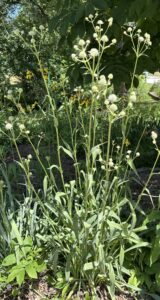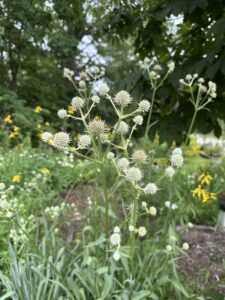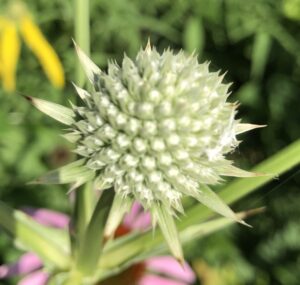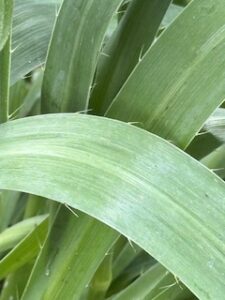Rattlesnake Master (Eryngium yuccifolium)

Light: Full to part sun.

Soil and water: Average garden soil, but well-drained soil is a must or the plant will rot. Will tolerate some drought. Once it is established, it only needs to be watered if there is a prolonged drought.
Hardiness Zone: Zones 4-9.
Size: 3-4 ft. tall and spread is 12-18”. If you decide to deadhead as the flowers fade, once the stalks are removed, this plant will be about 2 feet tall.
Bloom period and color. Deadheading: Blooms July and August. Greenish-white balls. I do allow the seedheads to form as I think they are attractive and I like their light brown color and knobby texture. I keep these seed head stalks in place until the following spring and in March, I cut them at ground level. By leaving them through the winter, I allow the plant to complete its natural cycle and to self-seed. However, this is your choice. You can deadhead them right after they finish blooming and before the seedheads form, you can deadhead them in fall, or you can deadhead them in early spring as I do. Regardless of when you deadhead, the plant will do well. Whenever you decide to deadhead, cut the entire flower stalk off at ground level.
Insects, butterflies, and birds: American Goldfinches like this plant and will forage on the flower heads. Click on this link to watch a video of a male goldfinch on this plant in our garden – keep your volume turned off because the neighborhood sounds are distracting. And this bird is too busy stuffing itself to sing! About halfway through the video, the female will join him. American Goldfinch Foraging in Our Front Garden
If you watch this video, you will get a good feel for this plant – how it looks after it is established. The bluish flowered plants in the background are Hoary Vervain – click here for more information on them. Hoary Vervain (Verbena stricta)
Deer, rabbits, and other pests: Deer and rabbits avoid them. Pest and disease free.

Propagating and transplanting: Self seeds, but it is not prolific. I have had it in my garden about five years and in that time, have only had about six volunteer plants. Watch for these volunteers in May. If you find some, this is a good time to transplant them to where you would like them – or to give them away to friends. Once these plants are established (mid-summer), they become increasingly difficult to impossible to transplant. Their taproot is long – even on a young plant – and it is easily broken. Once broken, the plant almost always dies. Choose your site carefully.
You can gather the seeds yourself from the seedheads and plant them right into a prepared site in your garden in September. Keep them moist until the first hard frost. If you want to start them indoors or in a prepared site in your garden the following spring, they will need a period of about 60 days of cold stratification.
What to plant with Rattlesnake Master: Keep in mind this plant can have two different appearances. In bloom, the stalks are quite tall giving this plant a lot of height. If you deadhead the flower stalks as the flowers fade – before seed-heads form – what remains is an attractive mound of lance-shaped leaves similar to daylilies or irises. Instead of the 4ft. flower stalks, the mound of leaves is closer to 2 feet tall. This is a big difference in height and appearance. If you are deadheading right after bloom, Rattlesnake Master can be planted with most other perennials – just keep in mind the watering requirements. These plants prefer a drier soil, so do not plant with perennials that like a wet soil. In my garden, I have Rattlesnake Master planted with Gray-headed Coneflowers (Ratibida pinnata) and close to Purple Coneflowers (Echinacea purpurea). If you have a large, hot, dry area of full sun, try planting Rattlesnake Master with one Yucca (Yucca) and add Prickly Pear Cactus (Opuntia humifusa) and/or Sedum (Hylotelephium) such as ‘Autumn Joy’. (Click on this link for more on Prickly Pear Cactus: Eastern Prickly Pear Cactus (Optunia humifusa) After planting, mulch the entire bed, and after the plants are established in 4-6 weeks, you should not have to water again unless there is a prolonged drought when gray water from your kitchen can be used.

How to use this Rattlesnake Master: This is a rather tall plant and not overly showy so it will look good, and be rather impressive, massed together at the back of a garden. It can also be interplanted with other perennials. In my garden, I have used it both ways and it looks good everywhere I have planted it. I think this plant is best when planted in a group. Because the flowers are not large or brightly colored, they can get lost among other summer bloomers. My recommendation is to plant them in groups of 3 or more.
Besides planting them in your flower garden, they can be planted along a shed, privacy fence, or wall to soften it, and break up the hard solid appearance of the structure.
Rattlesnake Master’s botanical name is Eryngium yuccifolium. ‘yuccifolium’ means ‘yucca-leaved’ and if you take a close look at Rattlesnake Master you will see the leaves do resemble the larger leaves of Yucca. Like Yucca leaves, the leaves of Rattlesnake Master are long, somewhat stiff, narrow, and bluish-green. The edges of the leaves of Rattlesnake Master have evenly spaced hairs or bristles and the entire plant is stiffer than most perennials. The tip of each leaf can be a bit sharp. This plant got its common name because Native Americans used the root as an antidote to rattlesnake venom.

